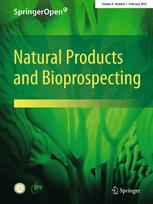|
|
New In Vitro Studies on the Bioprofile of Genista tenera Antihyperglycemic Extract
Collect
Daniela Batista,Pedro L.Falé,Maria L.Serralheiro,Maria E.Araújo,Paulo J.A.Madeira,Carlos Borges,Isabel Torgal,Margarida Goulart,Jorge Justino,Alice Martins,Amélia P.Rauter
Natural Products and Bioprospecting. 2015, 5 (6): 277-285.
DOI: 10.1007/s13659-015-0077-z
The inhibition of α-glucosidase and glucose-6-phosphatase, two enzymes involved in the carbohydrate metabolism, is an important target to control glycaemia on individuals with type 2 diabetes. In this work we report for the first time the inhibition of both enzymes by the antihyperglycemic n-butanol extract from Genista tenera(Fabaceae). This extract decreased a-glucosidase and glucose-6-phosphatase activities to 0.97 and 80.25%, respectively, being more effective than acarbose, and phlorizin, the positive controls, which reduced enzymes activities only to 17.39 and 96.06%. Once inflammation and oxidative stress are related to diabetic impairments, the anti-inflammatory activity of the extract was also evaluated, through its inhibitory activity over COX-1 enzyme(47.5% inhibition). Moreover, after induction of oxidative stress by UV radiation, the viability of irradiated rat liver hepatoma cells exposed to the extract was significantly higher(67.82%) than that promoted by ascorbic acid, the positive control(45.05%). In addition, the stability of the extract under gastrointestinal conditions was evaluated by HPLC-DAD-ESI-MS/MS. Flavonoid diglycosides were identified as the main constituents of the extract, and no alterations in the chemical composition nor in the antioxidant activity were observed after in vitro digestion with artificial gastric and pancreatic juices.
References |
Related Articles |
Metrics
|
|
|
Pterocarpadiols A-D, Rare 6a, 11b-Dihydroxypterocarpans from Derris robusta
Collect
Xiang-Mei Li,Mei-Fen Mao,Fu-Cai Ren, Xian-Jun Jiang,Ping Hai,Fei Wang
Natural Products and Bioprospecting. 2015, 5 (6): 287-291.
DOI: 10.1007/s13659-015-0078-y
Four hitherto unknown 6a, 11b-dihydroxypterocarpans, namely pterocarpadiols A-D(1-4), were isolated from the ethanol extract of the twigs and leaves of Derris robusta. Their structures were elucidated on the basis of extensive spectroscopic analysis. Pterocarpadiols A-D are a kind of very rare 6a, 11b-dihydroxypterocarpans, and their presence as markers may be helpful in chemotaxonomical classification.
References |
Related Articles |
Metrics
|
|
|
Diterpenoids from the Roots of Salvia yunnanensis
Collect
Fan Xia,Chun-Yan Wu,Xing-Wei Yang, Xian Li,Gang Xu
Natural Products and Bioprospecting. 2015, 5 (6): 307-312.
DOI: 10.1007/s13659-015-0080-4
Two new diterpenoids, salyunnanins I and J(1 and 2), together with ten analogues, were isolated from the roots of Salvia yunnanensis. The structures of the new isolates, possessing different neo-clerodane and seco-abietane diterpenoid skeletons respectively, were elucidated on the basis of comprehensive spectroscopic data. All of the compounds were tested for the inhibitory activities against six human tumor lines in vitro, and several ones showed moderate cytotoxic activities.
References |
Related Articles |
Metrics
|
|

